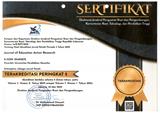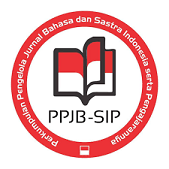ANALISIS FAKTA DAN SARANA CERITA DALAM TEKS NILAI MORAL FABEL SISWA KELAS VIII A1 DI SMP NEGERI 1 SINGARAJA
DOI:
https://doi.org/10.23887/jjpbs.v3i1.6602Abstract
Penelitian deskriptif ini bertujuan mendeskripsikan (1) fakta cerita yang digunakan dalam teks nilai moral fabel dan (2) sarana cerita yang digunakan dalam teks nilai moral fabel. Subjek penelitian ini adalah teks nilai moral fabel siswa kelas VIII A1 di SMP Negeri 1 Singaraja. Objek penelitian ini adalah fakta dan sarana cerita dalam teks nilai moral. Dalam penelitian ini yang menjadi instrumen utama adalah peneliti sendiri, karena penelitian ini tergolong penelitian deskriptif. Metode pengumpulan data dalam penelitian ini adalah metode dokumentasi. Metode dokumentasi digunakan untuk memperoleh data yang bersumber padatulisan seperti buku, majalah, dokumen, dan peraturan-peraturan. Data yang diperoleh dari hasil dokumentasi akan dianalisis melalui langkah-langkah, sebagai berikut (1) reduksi data, (2) penyajian data, dan (3) penyimpulan. Pada bagian ini dimuat hasil penelitian dan pembahasan hasil penelitian. Pada bagian ini hasil penelitian diuraikan (1) fakta cerita yang digunakan dalam teks nilai moral fabel siswa kelas VIII A1 di SMP Negeri 1 Singaraja, dan (2) sarana cerita yang digunakan dalam teks nilai moral fabel siswa kelas VIII A1 di SMP Negeri 1 Singaraja. Temuan yang pertama adalah fakta cerita yang digunakan siswa pada teks nila moral (fabel) yang meliputi tokoh, alur, dan latar. Temuan yang kedua adalah sarana cerita pada teks nilai moral yang meliputi judull, sudut pandang, gaya bahasa, dan tema.Kata Kunci : fakta, sarana, nilai, moral, fabel
This descriptive study aims to describe (1) the fact that the story is used in the text moral fable and (2) the means used in the story text moral fable. The subjects were text moral fable A1 class VIII SMP Negeri 1 Singaraja. The object of this study are the facts and means of stories in the text moral values. In this study, the main instrument is the researchers themselves, because these studies classified as descriptive research. Data collection method in this research is the method of documentation. Documentation methods used to obtain data sourced padatulisan such as books, magazines, documents, and regulations. Data obtained from the documentation will be analyzed through the steps, as follows: (1) data reduction, (2) presentation of data, and (3) inference. In this section, published the results of research and discussion of research results. In this section the results of the study are described (1) the fact the story used in the text moral fable eighth grade A1 in SMP Negeri 1 Singaraja, and (2) means the story used in the text moral fable eighth grade A1 in SMP Negeri 1 Singaraja, The findings of the first, is the fact that students use the story in text moral tilapia (fables) that include characters, plot, and setting. The findings of the second, is a means of narrative text that includes judull moral values, perspective, style, and themes.
keyword : fact, means, values, moral, fable
Published
2016-02-29
Issue
Section
Articles
License
Authors who publish with the Jurnal Pendidikan Bahasa dan Sastra Indonesia Undiksha agree to the following terms:- Authors retain copyright and grant the journal the right of first publication with the work simultaneously licensed under a Creative Commons Attribution License (CC BY-SA 4.0) that allows others to share the work with an acknowledgment of the work's authorship and initial publication in this journal
- Authors are able to enter into separate, additional contractual arrangements for the non-exclusive distribution of the journal's published version of the work (e.g., post it to an institutional repository or publish it in a book), with an acknowledgment of its initial publication in this journal.
- Authors are permitted and encouraged to post their work online (e.g., in institutional repositories or on their website) prior to and during the submission process, as it can lead to productive exchanges, as well as earlier and greater citation of published work. (See The Effect of Open Access)







